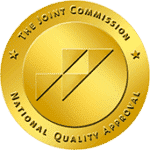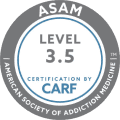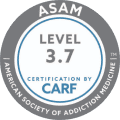Methadone Treatment
Methadone is a synthetic opioid that has been around for decades and has its share of benefits, like when it’s used to help someone stop using heroin and other opiates. Participants in a methadone program take medicine daily, administered by a clinician with the plan to reduce the dose over time until participants are weaned off completely. When followed correctly, the program works.
Unfortunately, because methadone is an opioid and produces effects like all other opioids, it has the risk of being abused, which can eventually lead to dependence and addiction. It’s important to understand the difference between dependence and addiction to recognize signs and symptoms and get help as soon as possible.
Methadone Dependence and Addiction
Addiction is not something that happens overnight. It is a process that starts the first time an opioid is consumed. The reasons for using methadone for the first time vary. Some use it to stop taking heroin; some use it to get high. In either case, the longer a person uses methadone, they build a tolerance to the drug.
Tolerance refers to the amount of methadone someone must consume to feel the same effects they did when they first started using it. The higher the tolerance, the more likely dependence on the drug will develop.
When trying to quit methadone or going without it for a few hours, the body starts to feel the effects of the drug leaving the system. The effects can be painful and are known as withdrawal symptoms. They are the body’s way of saying it relies on methadone to function.
Methadone Withdrawal Symptoms
Withdrawal symptoms are not pleasant. They can differ for each person depending on factors like length of use, the amount used, gender, and weight. Common withdrawal symptoms include:
- Nausea
- Vomiting
- Muscle pain and spasms
- Flu-like symptoms including chills, fever, and sweats
- Intense, obsessive thoughts about the drug
To avoid these adverse effects, it becomes necessary to keep using methadone. Without realizing it, a person gets caught in a vicious cycle where most of their day is spent seeking and using methadone. The brain convinces them they need methadone to survive.
The brain can be so convincing because methadone alters its structure and chemicals, making it easy to become addicted and extremely difficult to quit.
Methadone and the Brain
As soon as methadone is consumed, it travels through the bloodstream to the brain. When it reaches the brain, it triggers the release of dopamine neurotransmitters, the feel-good chemicals. Dopamine is produced naturally by the brain. But when taking an opioid, the amount of dopamine produced is much higher. It makes natural dopamine production feel nonexistent.
When released, dopamine floods the reward center in the brain, producing euphoric effects. There’s no doubt about it; it feels good, creating a sense of calm and relaxation all over the body. The euphoric reactions don’t last long, however. After about half an hour, the effects start to fade. The brain wants to continue feeling good, so it finds ways to encourage continued use of the methadone by making withdrawal symptoms and cravings more intense.
Before long, using methadone becomes much more about avoiding withdrawal symptoms and less about feeling high. This goal is a sign of addiction to methadone. Eventually, more obvious signs of methadone use disorder appear.
Signs of Methadone Addiction
Having a methadone use disorder is like other opioid use disorders. Because the drug affects the mind and body, psychological and behavioral signs are present. Common signs include:
- Participating in risky behaviors to get money to purchase or trade for methadone, like
- Lying to get money from family or friends
- Stealing from strangers
- Stealing from family or friends
- Prostituting
- Dealing drugs
- Trading street drugs for someone else’s prescription methadone
- Hiding or being sneaky about the use of methadone
- Isolating from friends and family
- Significant changes in weight and hygiene
- Change in friends and now hanging out with drug friends
- Loss of employment due to drug use
- Broken relationships due to drug use
- Loss of material things like cars, homes, and other belongings due to drug use
- Damage to physical health due to drug and method of drug use (abscesses, infections, organ dysfunction)
Despite all the above negative actions and consequences, someone with a methadone use disorder cannot stop using it on their own. The drug is in control. To quit using methadone long-term, treatment is necessary. Fortunately, following a step-down treatment program like the one detailed below has helped many enter recovery and maintain it long-term.
Methadone Treatment
Treatment for any opioid use disorder must start with detoxification, preferably a medically supervised program.
Medically Supervised Detox
Medically supervised detox may seem like an odd choice since methadone itself helps people quit taking opioids. But again, methadone is an opioid. Therefore, the treatment team may choose to aid detox with medicine like Suboxone, which eases withdrawal symptoms and blocks opioids from binding to opiate receptors in the brain. Essentially, if you are taking Suboxone and decide to take methadone, too, you will not be able to feel the effects of methadone or any other opioid.
Medically supervised detox takes place in an inpatient setting with round-the-clock care by medical professionals, including psychiatrists, physicians, nurses, and therapists. The goal of medically supervised detox is to treat withdrawal symptoms to ensure the highest level of comfort.
Each symptom of withdrawal may be treated separately. If you experience migraines, doctors can prescribe medicine to alleviate the pain. If you can’t sleep, doctors can prescribe something to help you rest. As symptoms improve, recovery therapy can begin. Most people do this in a residential treatment facility.
Residential Treatment
Also called inpatient rehab, residential treatment offers a longer stay, ranging from 30 to 90 days. Multiple types of care are provided in residential treatment to address physical, psychological, and recovery needs. Most residential treatment programs provide:
- Medication management to continue treating cravings and withdrawal symptoms.
- Individual Counseling to work one-on-one with a licensed therapist to identify and move on from the reasons you started using methadone. Techniques used include:
- Cognitive-behavioral therapy
- Contingency management therapy
- Motivational Enhancement Therapy
- Group Counseling to gain support from peers in therapist lead activities. Groups typically focus on:
- Relapse prevention skills
- Addiction education
- Early recovery skills
- Life skills improvement
- Dual diagnosis (having both a mental health and substance use disorder)
If a doctor feels medication-assistance treatment should continue after being discharged from inpatient rehab, it will be crucial to attend an intensive outpatient program. Medication assistance is not a permanent solution, and the weaning-off period should be accompanied by maximum support.
Intensive Outpatient Program (IOP)
IOP provides ten or more hours weekly of combined individual, group, and family education and therapy and incorporates social support groups, 12-Step groups, and recovery activities. Over 16 weeks, a team of mental health and addiction specialists provide services, evaluate progress, and adjust treatment plans as needed.
Once completed, treatment becomes less frequent but is still needed to support long-term sobriety. Most people opt for individual counseling and the continuance of social support groups.
Individual Counseling and Community Support Groups
If continuing a medication-assistance program after intensive outpatient, it’s important to stay in some form of treatment, even if limited. Meeting with the prescribing doctor is great, but they don’t provide the support a therapist can give for processing life changes, mental health issues, family problems, and even successes experienced in recovery.
Community support groups are a place for peers in recovery to gather, share successes and struggles, hear from speakers in the field of recovery, and enhance recovery skills. Support groups like AA and NA exist nationwide. Treatment facilities, hospitals, and local agencies typically offer groups for families and mental health issues to provide even more support for recovery.
Each level of methadone addiction treatment provides the individual with knowledge on how to overcome addiction. The more knowledge gained, the better the chance for recovery success. Knowledge is power. It can build confidence, improve skills, and assist in the battle against methadone addiction.
Because you can’t know what will happen in the future, good or bad, it’s a good idea to keep support systems in place. Think of all treatment options as a gift to yourself. They are rewards that help you build a healthy, happy, sober life.
Getting Started
At The Haven New England, we understand that taking the first step is sometimes the hardest. That’s why all we suggest is making a phone call to learn more about the treatment process, medication-assistance programs available, and which level of treatment is right for you.
Our counselors are available to provide answers about methadone 24/7. Call (844) 933-4145 to reach a member of our team. We can help you whether you have just started using methadone or feel you may be addicted. We are here for you.
Verify Insurance
Let’s get you or a loved one help with a few simple steps.



